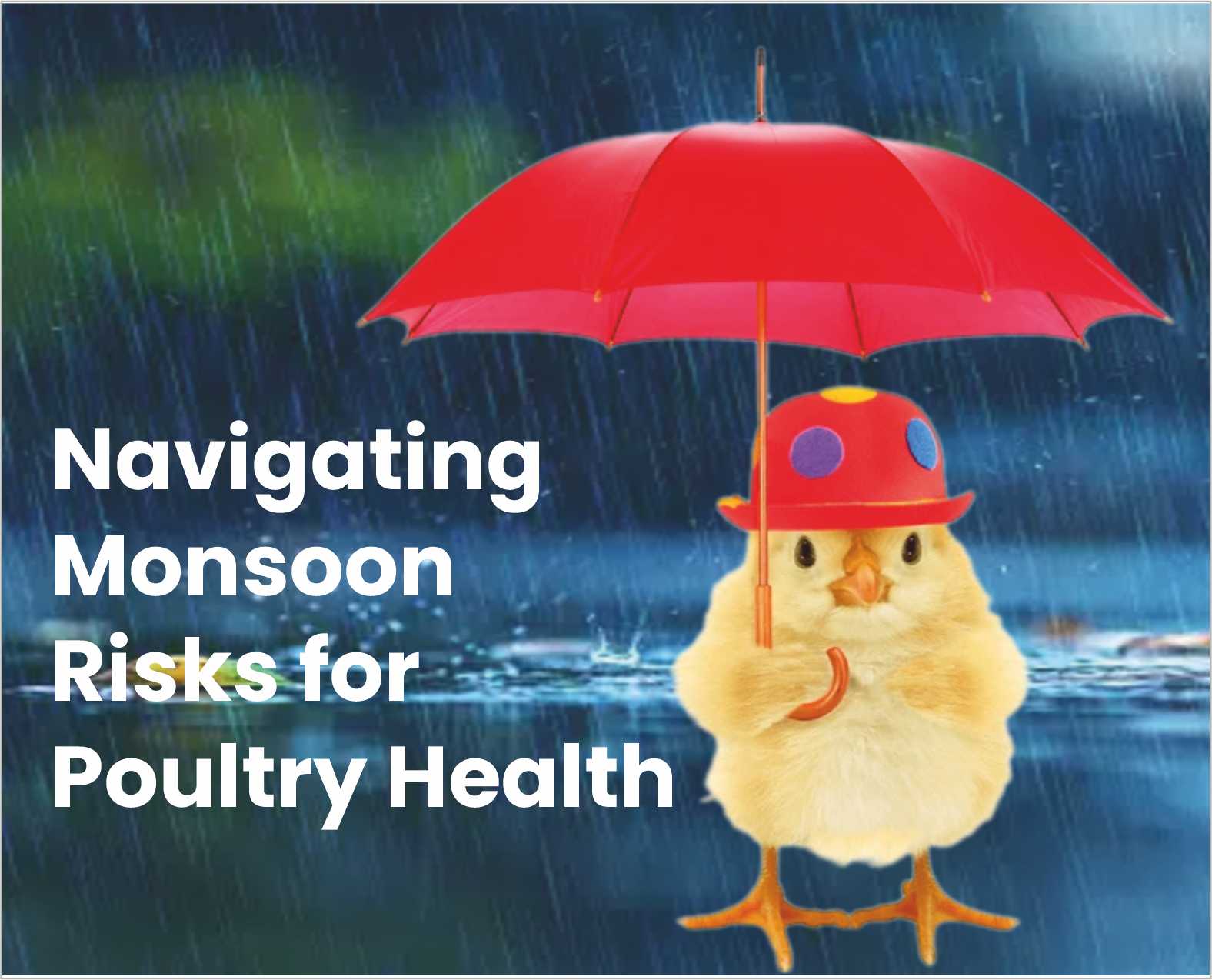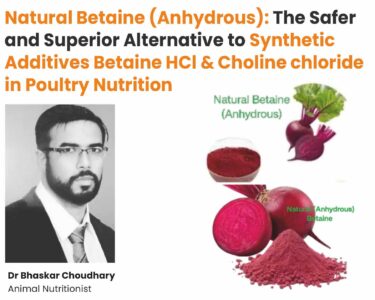Navigating Monsoon Risks for Poultry Health

Dr. Anvesha Bhan1, Dr. Sundus Gazal2 and Dr. Sabahat Gazal3
Division of Veterinary Microbiology and Immunology, Sher-e-Kashmir University of Agricultural Sciences and Technology of Jammu
The poultry sector is among the fastest-growing industries, playing a crucial role in providing employment, income, and animal protein to both urban and rural populations, while also serving as manure for crops. Despite the global increase in meat supply, challenges such as bird handling, housing, rearing, and disease control still hinder the industry’s progress. During the monsoon season, continuous rainfall can lead to higher relative humidity and lower temperatures, affecting both the quality and quantity of feed. Additionally, wind speed can influence disease outbreaks. These weather changes impact poultry production, particularly for laying birds, as egg production declines in extremely cold or hot weather. Such conditions stress the birds, compromising their immune systems and reducing their disease resistance. Some of the common poultry diseases during the rainy season are:
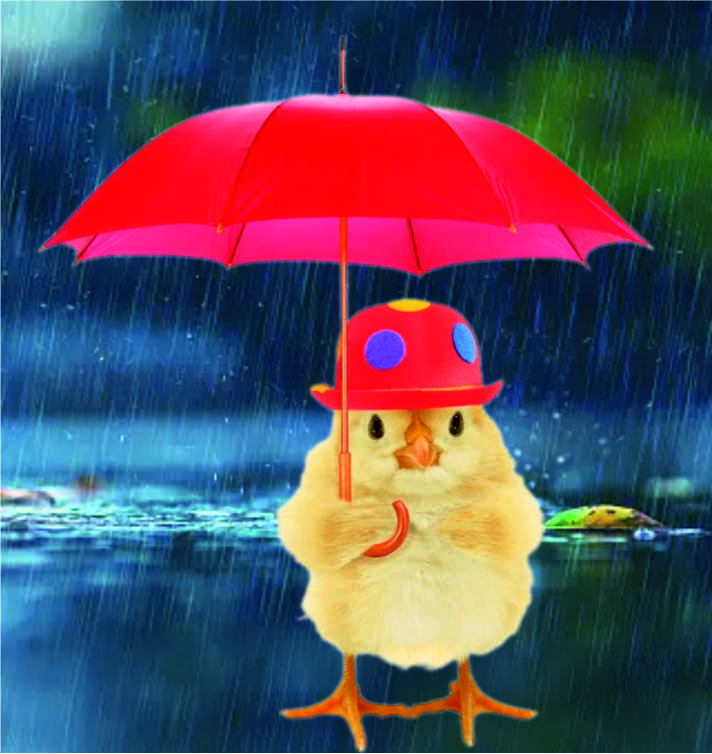
Fowl Pox: Fowl pox is a highly contagious disease affecting poultry birds of all ages, caused by a poxvirus transmitted mainly by mosquitoes and other blood-sucking insects. The prevalence of fowl pox increases during the wet season due to the abundance of stagnant water, which provides breeding grounds for mosquitoes. Additionally, wet litter from poorly shielded poultry houses can lead to fly problems. Fowl pox exhibits round lesions with scabby centers on the birds’ skin, primarily on the wattle, face, comb, and occasionally on the legs. It can also affect the mouth and windpipe, causing lesions that may block the throat and lead to suffocation. Lesions on the face can spread to the eyes, potentially causing temporary or permanent blindness.
Fowl Cholera: Fowl cholera is a bacterial disease caused by Pasteurella multocida, affecting birds aged 6 weeks and above. It is highly contagious with high mortality in acute cases. The bacterium spreads readily during the rainy season as wet litter harbors numerous microorganisms.In acute cases, birds may die suddenly without prior signs, while chronic cases show symptoms similar to fowl typhoid, including yellow, green, or grey diarrhea; loss of appetite; labored breathing; drooped wings and tail feathers; ruffled feathers; swelling of leg joints, sinuses, wattles, and footpads.
Salmonellosis, Colibacillosis, Pullorum Disease (Bacillary White Diarrhea): These bacterial diseases affect birds of all ages and thrive in farms with poor sanitation, especially when wet litter is left unchecked. They impact the digestive system, presenting symptoms such as severe diarrhea, loss of appetite, depression and emaciation, chicks suffering from omphalitis, white pasty diarrhea in pullorum disease, huddling together and labored breathing.
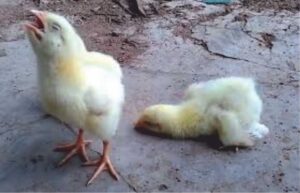
Aspergillosis: Aspergillosis, caused by Aspergillus fumigatus, is prevalent during the rainy season due to high humidity, which dampens feed and litter, creating a conducive environment for fungal growth. Inhalation of Aspergillus spores lead to respiratory issues and lesions in the lungs. It is exhibited as Acute form which is common in young chicks and is characterized by rapid onset and high mortality with symptoms like lethargy, depression, loss of appetite, difficulty breathing, and cyanosis; or as Chronic form which develops subtly over weeks or months and affects older birds with symptoms like weight loss, reduced appetite, respiratory issues, and changes in vocalization.
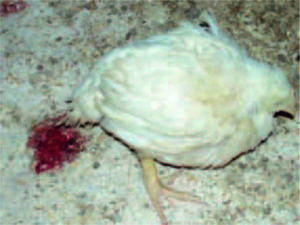
Coccidiosis: Coccidiosis, a parasitic disease caused by the protozoan Eimeria spp. is an intestinal infection which causes extensive intestinal damage. It is widespread in poultry and game birds during the rainy season where wet litter and high pen temperatures favour the sporulation of oocysts of the parasite. Clinical signs include bloody faeces, ruffled feathers, anaemia, somnolence, severe diarrhoea, and high mortality. Decreased growth, feed and water consumption, weight loss, and decreased egg production are common. Infected survivors may suffer long-term performance loss.
Managemental Practices in Monsoons: Achieving Maximum Efficiency
The monsoon season brings challenges such as high relative humidity and temperature fluctuations. These extreme weather conditions create a favourable environment for the propagation of various pathogenic organisms, including bacteria, viruses, fungi, parasites, and vectors like flies and mosquitoes. This necessitates careful consideration and appropriate measures to optimize bird health and ensure efficient production.
Housing Management for Poultry During Monsoon:
A well-maintained shed is crucial for minimizing climatic stress and health challenges in poultry. Before the monsoon season, it is important to inspect the roof and walls for any holes or leaks and repair them promptly. Ensure the drainage ditch around the shed is clear to prevent waterlogging. The roof should have side overhangs of at least 3 to 4 feet to prevent rainwater from entering the shed. Cover the side walls of the empty shed with polythene curtains that are in good condition and can be adjusted based on ammonia concentration or rain intensity. Improper curtain management can lead to poor ventilation, resulting in ammonia buildup, which can cause issues such as improper digestion, abnormal respiration, and a high incidence of ascites. During the day, allow 1-2 feet opening at the top of the side curtains to ventilate ammonia and other undesirable gases. Atleast a 10-feet perimeter outside the shed should be kept clean and free of bushes and grasses. Waterlogging in the surrounding area can lead to propagation of insects like mosquitoes and flies inside the shed and since these act as vectors for many infectious diseases, proper cleanliness and pest control becomes crucial. To control the insect population regular spray of insecticides like bleaching powder and formalin (3-5%) should be done.

Litter Management in Poultry Housing During Monsoon:
A good litter material absorbs moisture when the surface is moist and the air is humid, and releases moisture when the air is dry. Ideally, the litter moisture content should be between 25% and 30%. If moisture falls to around 20%, the litter becomes too dusty, and if it rises to around 40%, the litter becomes wet and caked, which is undesirable. There are various issues that are faced with poor litter management viz., wet and caked litter promotes rapid microbial growth, which may cause infections leading to irritation, cracking, and infection of the foot. High moisture content in litter leads to ammonia buildup in the poultry house. Ammonia and other noxious gases can damage the respiratory tract lining, exposing birds to infections. Although the maximum permissible level of ammonia in the litter is 25 ppm, but adverse reactions including irritation of the eyes and respiratory tract start appearing at concentrations as low as 6 ppm, while reduced animal performance may be observed at 11 ppm. Thus, the level of ammonia in the shed must be kept at the minimum.
1. Moisture Control:
– Regularly check litter moisture. Compress the litter sample in hand; if it shows crevices and gently falls apart, moisture is optimal. If it forms a cohesive ball, it is too wet. If it crumbles easily, it is too dry.
– If litter moisture exceeds 40%, it indicates wet and caked litter which requires immediate disposal and replacement with fresh litter.
– Practice litter racking twice a day to prevent caking.
– To reduce litter moisture, add 1 kg of slaked lime and 150 gm of bleaching powder per 100 ft² of floor area.
– Operate ceiling fans at a ratio of one fan per 300 birds in deep litter broiler farms.
2. Overall Maintenance:
– To prevent mold growth, treat new litter with a 2% aqueous solution of copper sulphate spray.
– Regularly inspect and maintain the poultry house roof and walls to prevent leaks and ensure good drainage around the shed.
– Use polythene curtains to cover side walls and adjust them based on ammonia concentration and rain intensity, allowing for proper ventilation.
– Maintain cleanliness around the shed, keeping at least a 10-foot perimeter free from bushes and grasses to prevent waterlogging and insect breeding.
– Use insecticides, bleaching powder, and formalin spray (3-5%) outside the shed to control insect populations.
Feed and Water management to navigate through the Monsoon Season
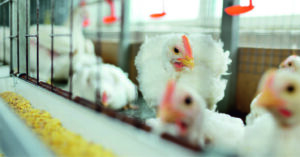
Feed Management:
1. Adjust diet formulations to include all vital nutrients, considering the reduced feed intake of the birds due to high temperature and humidity.
2. Avoid long-term storage of feed as shelf life is shorter due to high humidity.
3. Prevent feed from heating up or forming lumps, which indicate decomposition and mold growth.
4. Ensure that vehicles for feed transport are leak-proof and maintain a 4-5 day extra feed stock to avoid frequent transportation during rainy days.
5. Use a Dunnage system to store feed bags. Stack bags on wooden or bamboo pallets at least 1 foot off the floor and away from side walls to avoid moisture contact and allow air circulation.
6. Implement a FIFO (First In, First Out) system for feed distribution.
7. Avoid wooden feed troughs to prevent mold growth and toxin production. Use plastic troughs for easier cleaning and disinfection.
8. Clean the feeders daily with a dry cloth.
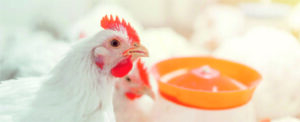
Water Management:
1. Ensure clean, safe water supply as it significantly impacts flock performance.
2. Regularly sanitize water to prevent contamination, especially during the rainy season when E. coli and other coliform counts are higher.
3. Use water sanitizers with sufficient contact time and proper dosing.
4. Acidify drinking water to lower the pH, which reduces bacterial growth. Drinking water pH should preferably be around 5.0 to 5.5 to inhibit most pathogens. Poultry prefer water with a pH of 6 to 6.8.
5. Clean drinkers daily with detergents and bleaching powder to reduce water-borne diseases.
6. Clean pipelines at least once a week to reduce biofilm formation.
7. Monitor Oxidation-Reduction Potential (ORP) to evaluate the effectiveness of water sanitizers. An ORP value > 650 mV indicates good quality water, which can be effectively sanitized with 2-4 ppm free chlorine.


